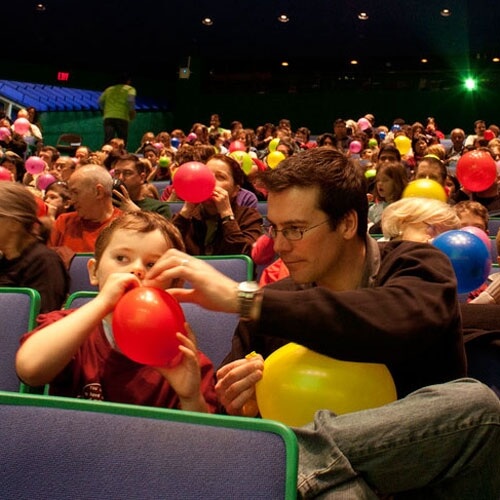News
Families in the Science Center inflated balloons, charging them with potential energy, which would soon be released with great amusement.
Research assistant Daniel Rosenberg, a key member of Harvard's science lecture demonstration team, introduces some very young students to a low-friction air track to explore the conservation of energy. (Photos by Caroline Perry, SEAS Communications.)
The air rushed out of 400 deflating balloons with an ear-splitting squeal—a perfect demonstration of the conversion of potential energy to kinetic—again, and again, and again.
Children from Cambridge and beyond experienced energy in all its forms at a Holiday Lecture hosted by the Harvard School of Engineering and Applied Sciences (SEAS) on December 9.
“Powerful Potential: The Gift of Energy,” engaged families with some of the principles of physics that govern everyday actions, bringing them to life with exciting demonstrations, sports videos, audience participation, and explosions.
“Energy is behind practically everything, whether it is motion, technology, or the processes of living organisms," said Howard Stone, a former Harvard faculty member and now Dixon Professor in Mechanical and Aerospace Engineering at Princeton University, who delivers the lecture each year with the help of research assistant Daniel Rosenberg, a key member of Harvard's science lecture demonstration team.
"From turning on the light to driving cars, taking the subway, or using your cell phone or iPad, everything requires energy," Stone added.
Through videos of sporting events from the summer and winter Olympics, Stone explained how potential energy (the capacity to do work) is converted to kinetic energy (movement), adding that Harvard undergraduates would be "taking an exam on this next week."
Watching a record-setting ski jump and a champion pole vaulter who catapulted himself 20 feet in the air, the audience called out, "Kinetic!" "Potential!" "Kinetic!"
Rosenberg used a pendulum to demonstrate the conservation of energy. Standing with his back to a wall, he held a 65-pound weight against his chin and released it, confident that it would not return far enough to strike him in the face. It did come alarmingly close.
Stone’s 12-year-old daughter Taylor was enthralled by the demonstrations.
“I found it interesting how the different types of energy in the pendulum didn’t let it hit him,” she said, bubbling with energy of her own. “I also liked the ski jump.”
After laying the foundations, Stone ventured into the realm of chemistry, explaining that in addition to the forms of energy that we can see, energy at the micro- level is stored in molecules.
Rosenberg put this theory to the test by holding a flame to a hydrogen-filled balloon. After several seconds, the balloon exploded into a fireball, and the whole audience let out a gasp.
Luke Ledger and Paige Patnaude, both 6-year-old children of researchers from Manchester, NH, were fascinated by the “moving energy” that they witnessed.
“I liked when they put the light to the balloon,” Paige said shyly. Although the explosion initially frightened her, she was eager to learn about the science that caused it.
The most engaging demonstrations of all were not the thrilling explosions or the ones that used props, but rather those that enabled the children to demonstrate what they had learned to their peers and their parents.
The children mimicked molecules under pressure, escaping from a balloon.
Designating volunteers to play hydrogen and oxygen atoms, Stone walked them through hydrolysis and combustion. The children, now converted to water molecules, returned to their seats hand-in-hand in trios (two hydrogens and one oxygen) shouting “BOOM” even louder than the bursting balloon.
Conservation of energy, kinetic and potential energy, and hydrolysis all came together in a final demonstration, as Stone climbed onto a stationary bicycle and pedaled to generate electricity. That energy was carried to a large glass tube full of water, splitting the liquid molecules into oxygen and hydrogen gas, which Rosenberg lit with a “pop.”
Stone and Rosenberg brought such excitement to science and engineering that most of the children rushed to the stage at the end of the presentation to ask questions and reenact their favorite demonstrations.
“Our goal was to have families celebrate together the wonder of the natural world and the science that is all around us,” said Kathryn Hollar, Director of Educational Programs at SEAS, who fielded questions after the lecture, greeting children with a smile.
“Families who return year after year tell us that these lectures nurture the natural curiosity of the children,” she added, “and re-ignite that sense of wonder and curiosity in the adults.”
The Holiday Lecture, a decade-long tradition at Harvard, is made possible with support from the Center for Nanoscale Systems (part of the National Nanotechnology Infrastructure Network), and two National Science Foundation–supported sites at Harvard, the Materials Research Science and Engineering Center and the Nanoscale Science and Engineering Center, in addition to SEAS.
Cutting-edge science delivered direct to your inbox.
Join the Harvard SEAS mailing list.
